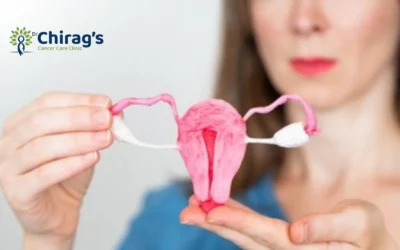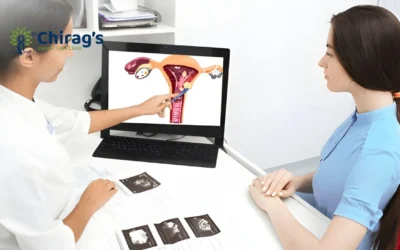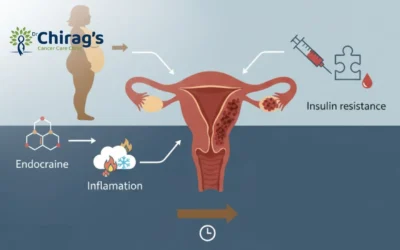Does endometrial cancer cause postmenopausal bleeding?

As a cancer surgeon, I want to address this directly: Vaginal bleeding that occurs a year or more after your final menstrual period—what we call Postmenopausal Bleeding (PMB)—is never normal and must be investigated immediately.
I understand this sounds alarming, but I tell patients this not to frighten them, but because it is an early warning sign we need to respect. In the majority of cases, the cause is benign and easily managed.
However, because PMB is also the single most common symptom of endometrial (uterine) cancer, we must act swiftly and systematically to rule out a serious condition.
Think of it as a signal your body is giving us—and my team is here in Pune to interpret that signal with the highest level of expertise and compassion.
If it’s not normal, does postmenopausal bleeding always mean it’s cancer?
Absolutely not. I can confidently share that in about 90% of cases, postmenopausal bleeding is caused by non-cancerous conditions.
The most frequent culprits are things like atrophic vaginitis or endometritis, where the thinning of the vaginal or uterine lining due to the natural drop in estrogen makes it fragile and prone to spotting.
We also see benign growths like endometrial polyps or fibroids, which can cause irritation and bleeding. Even changes in your Hormone Replacement Therapy (HRT) regimen can lead to unexpected spotting.
However, that remaining 10% is why a prompt evaluation is non-negotiable. This is the group where bleeding may be a sign of endometrial hyperplasia (a pre-cancerous thickening of the uterine lining) or, indeed, a diagnosis of endometrial cancer.
The key takeaway is to see your doctor so we can determine if you are in the 90% benign group or the 10% that requires specialized intervention.
What are the main risk factors for endometrial cancer that I should know about?
When we discuss risk factors for endometrial cancer, it often comes down to the influence of estrogen. This cancer is strongly linked to conditions that lead to higher lifetime exposure to unopposed estrogen. You should be particularly aware of:
- Obesity: This is a major factor, especially relevant in the rising health trends across India. Fat tissue converts other hormones into estrogen, increasing the risk substantially.
- Diabetes and Hypertension: These metabolic conditions frequently co-exist with obesity and significantly compound your risk.
- Age: The risk increases as you grow older, with most diagnoses occurring after menopause.
- Reproductive History: Having never been pregnant (nulliparity) or starting your periods very early and going into menopause very late.
- Family History: A genetic predisposition, particularly the presence of Lynch Syndrome in the family.
By controlling the modifiable factors like weight and diabetes, you are taking proactive steps in preventive oncology.
What tests will you do to find the cause of my bleeding?
The diagnostic process is designed to be as swift and minimally invasive as possible while ensuring a definitive answer. My primary goal is to provide a tissue diagnosis to confirm or rule out cancer.
- Pelvic Examination and Detailed History:
We start with a thorough clinical assessment to understand the nature of your bleeding and your medical background. - Transvaginal Ultrasound (TVS):
This quick and painless scan helps us measure the Endometrial Thickness (ET). If your ET is greater than 4 millimeters after menopause, it is a significant red flag that strongly mandates further investigation. - Endometrial Biopsy (Pipelle Biopsy):
This is a simple, outpatient procedure where we collect a small tissue sample from the uterine lining. While it may cause a moment of discomfort, it often provides the crucial diagnosis right away. - Hysteroscopy with Directed Biopsy:
If the initial biopsy is inadequate, or if the ultrasound shows a focal abnormality (like a large polyp), we proceed to this gold-standard test.
Hysteroscopy allows me to visualize the uterine cavity directly with a tiny camera and take a targeted biopsy from any suspicious area. This level of precision is vital for an accurate diagnosis, a hallmark of the Cancer Care Clinic in Pune.
If it is endometrial cancer, what happens next with treatment?
Should the tissue biopsy confirm endometrial cancer, please know that the prognosis is often excellent because PMB typically helps us catch it at a very early stage.
The cornerstone of treatment for early-stage endometrial cancer is surgery—specifically, a total hysterectomy (removal of the uterus) along with the fallopian tubes and ovaries.
We perform these procedures robotically or laparoscopically here at my practice, which ensures smaller incisions, less pain, and a faster return to your routine.
As an Onco Surgeon in Pune, my role is to then stage the cancer—determining if it has spread—which usually involves assessing the nearby lymph nodes.
Depending on the stage and the specific type of cancer found, some patients may require follow-up treatment like external beam radiation or chemotherapy (adjuvant therapy), but this is a personalized plan we discuss with you in detail.
Beyond the surgery, what about my recovery and emotional health?
A cancer diagnosis and subsequent treatment impact a person on multiple levels. Physically, most women recover well from minimally invasive surgery within a few weeks. We focus on proper wound care, pain management, and a gradual return to activity.
Emotionally, it’s normal to feel anxiety, fear, and even grief. We integrate supportive care services because managing your emotional well-being is just as critical as managing the disease.
Support groups and counseling can be incredibly beneficial. For the long term, we emphasise crucial lifestyle changes—particularly maintaining a healthy BMI and managing co-existing conditions like diabetes.
For deeper clarity and to avoid common misunderstandings, many of my patients also find it helpful to read Endometrial Cancer: Myths vs. Facts, which clears up several misconceptions while strengthening awareness.
This is not just about general health; it’s a medically proven strategy to reduce the risk of cancer recurrence.
What simple steps can I take to reduce my overall risk of female cancers?
Prevention is always better than cure, and simple lifestyle adjustments can have a profound impact.
- Achieve and Maintain a Healthy Weight: This is the single most powerful action you can take to lower your risk for endometrial cancer.
- Manage Chronic Conditions: Keep your blood pressure and blood sugar levels strictly under control through diet, exercise, and medication as prescribed.
- Prioritize Physical Activity: Regular movement helps regulate hormones and improve overall metabolism.
- Be Vigilant with Symptoms: Any abnormal bleeding, particularly after menopause, should be addressed immediately. Do not delay consultation out of fear.
Frequently Asked Questions (FAQs)
1. How long after I stop HRT can I expect to see spotting, and when should I worry?
Spotting is common for a few weeks to a couple of months after starting, stopping, or changing HRT. However, if the bleeding is persistent, heavy, or continues beyond three months after an HRT change, you must get it evaluated, as it needs to be differentiated from a serious underlying cause.
2. If my endometrial thickness is less than 4mm on TVS, can I be sure it’s not cancer?
A thickness of less than 4-5mm makes the risk of endometrial cancer extremely low (less than 1%). While not a 100% guarantee, it is highly reassuring, and further invasive testing is usually not necessary unless you have very persistent bleeding.
3. Does a "negative" Pap smear (Cervical Screening) mean I don't have endometrial cancer?
No, a Pap smear is a screening test for cervical cancer, not endometrial cancer. A normal Pap smear is reassuring for your cervix but does not rule out a problem in the lining of your uterus (endometrium).
4. Is a D&C (Dilation and Curettage) still used to diagnose postmenopausal bleeding in India?
While D&C was a traditional method, it is largely replaced now by the more modern, less invasive, and more precise techniques like Pipelle biopsy and Hysteroscopy with directed biopsy, which allows for better detection of focal lesions.
5. Will losing weight help reduce the chances of my endometrial cancer recurring?
Yes, absolutely. Since fat tissue produces estrogen, reducing excess weight post-treatment is a critical long-term strategy. It helps lower circulating estrogen levels, which directly contributes to reducing the risk of recurrence and improving overall survival.
Conclusion
I want to end on a supportive and encouraging note. Postmenopausal bleeding is a symptom that demands your attention, but it is also a powerful opportunity for early detection.
The moment you notice any spotting or bleeding, your next step should be to consult a specialist. Early diagnosis of endometrial cancer is highly curable, and with advancements in surgical oncology and compassionate, comprehensive care, we offer our patients the very best chance for a healthy future.
Contact me, Endometrial Cancer specialist in pune for a personalized, confidential consultation. For expert guidance and treatment options in Pune.
If you have any further queries, please write to us.
Latest Blogs
Is Endometrial Cancer The Same As Uterine Cancer?
Endometrial cancer is the most common type of uterine cancer. Learn symptoms, diagnosis, stages, and treatment options from Dr. Chirag Bhirud.
Does Fluid in the Endometrial Cavity Mean Cancer?
Fluid in the endometrial cavity doesn’t always mean cancer. Learn causes, diagnosis, and treatment from Dr. Chirag Bhirud, Cancer Specialist in Pune.
Obesity & Endometrial Cancer: What’s the Connection?
Learn how obesity raises endometrial cancer risk. Dr. Chirag Bhirud, Onco Surgeon in Pune, explains causes, symptoms, and preventive care in simple terms.






